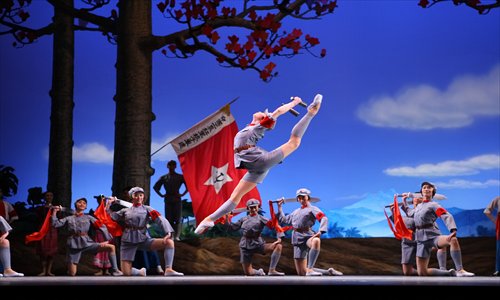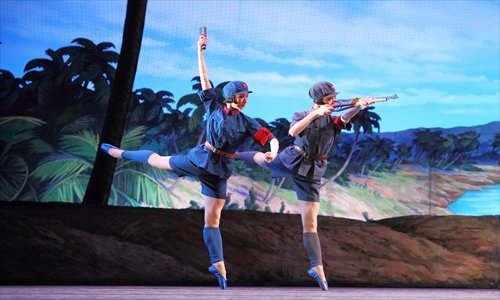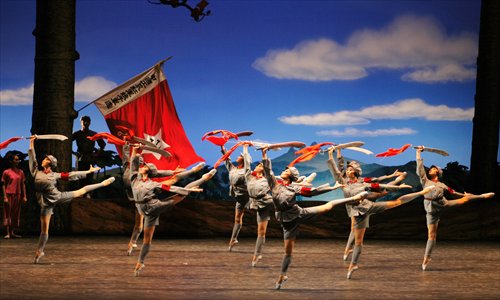A revolution in dance

The 1987 John Adams opera, Nixon in China, based on the former US president's ground-breaking trip to China in 1972, contains a scene where Nixon and his wife Pat are watching a performance of one of the era's "eight model works." Also in attendance was former premier Zhou Enlai, and Chairman Mao's wife Jiang Qing.
The ballet they saw was The Red Detachment of Women. And in Adams' reimagining of that night, we see Pat Nixon falling under the spell of the action and rushing to help a persecuted character on stage who she really believes is being whipped to death.
Memories of both this opera - and the original ballet - came flooding back last week with a performance of The Red Detachment of Women at the Shanghai Cultural Square as part of the 14th Shanghai International Arts Festival.

Cruel and unscrupulous
The Red Detachment of Women was the first uniquely Chinese ballet and was conceived by the National Ballet of China (NBC) in 1964.
Originally a novel, and later, an award-winning film, the plot follows the attempts of young woman, Wu Qionghua to overthrow a cruel and unscrupulous landlord, Nan Batian, with the help of a young communist, Hong Changqing.
The ballet takes place against the idyllic backdrop of Hainan Island.
In the first volume of Henry Kissinger's memoirs, White House Years, he quotes Nixon's comment about the performance: "I had not been particularly looking forward to this ballet, but after a few minutes, I was impressed by its dazzling technical and theatrical virtuosity. Jiang Qing had been undeniably successful in her attempt to create a consciously propagandistic theater piece that would both entertain and inspire its audience. The result was a hybrid combining elements of opera, operetta, musical comedy, classical ballet, modern dance, and gymnastics," he wrote.
Nearly 50 years later, this ballet is still being staged regularly both in China and abroad.
According to NBC director Feng Ying, the company is now working with the fifth generation of dancers to perform this legendary work. "I myself was among the third generation when I first played the role of Wu in 1992. And today, learning the choreography for The Red Detachment of Women has become a required course for every dancer in the company," she said.
Zhang Jian, one of the current corps of dancers, regularly plays the role of Wu. She told the Global Times: "It is not difficult to master the dance movements as long as you are given the necessary training; the difficult thing is to portray the full revolutionary passion that the original dancers would have displayed on stage. After all, we never experienced that era. The ballet is indeed a product of its time and, unavoidably, has the political overtones of that time."
During the Cultural Revolution (1966-76), it was one of only eight productions allowed to be staged in China, and enjoyed a favorable reputation among the country's leadership of that time, notably Jiang. The ballet was banned after the end of the Cultural Revolution and wasn't performed again in China until 1992.
"In many Chinese artists' opinion, The Red Detachment of Women is undoubtedly of epoch-making significance in the history of ballet, not only in China, but also the whole world," said Feng. "It brought forth completely new ideas on the form of ballet, not only in content, but also in costume design and choreography."

Graceful movements
Before The Red Detachment of Women, it is safe to say few people had ever seen an elegant ballerina dressed in a military uniform with short pants and brandishing a rifle. The choreography was influenced as much by the graceful presence of Peking Opera artists, as it was by serenity of military-style movements.
"The score was influenced by the ethnic music of the Li people who live on Hainan Island," Feng told the Global Times.
She added that from February to early September 1964, the entire cast of 130 was taken to Hainan Island for research, and they also stayed at an army garrison in Datong, Shanxi Province, to learn how to handle firearms and to observe soldiers at close quarters. "There, the dancers lived together with the soldiers and joined in their regular training every day, including shooting, bomb-dropping, bayonet fighting and quick marching," Feng said.
At the end of the debut performance in September 1964 in the Great Hall of the People in Beijing, Chairman Mao gave his official verdict: "The orientation is right, the revolutionary aspect is successful and the art is good."